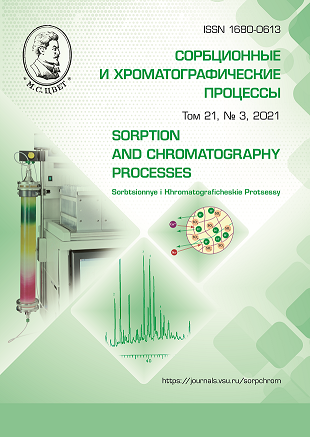Comparison of the capabilities of carbon sorption-active materials for the express concentration of volatile organic compounds from the flow of analysed air
Abstract
Carbon sorbents are widely used for dynamic sorption concentration of analytes in air analysis. However, carbon and especially nanocarbon sorption-active materials have one significant drawback. Too small particles of these materials often impede their direct use in air analysis due to the low permeability of the sorption layer. The problem of low permeability of microdispersed sorption-active materials can be solved using composite surface-layer sorbents, in which these materials are located on the surface of a relatively coarsely dispersed carrier.
The main goal of this study was assessment of the capabilities of surface-layer sorbents based on various carbon materials for the rapid concentration of highly toxic volatile organic compounds (medium alcohols and phenols). Surface-layer sorbents based on commercially available carbon nanotubes (Bauer, Dealton, Taunit-MD) and nanotubes synthesized by us using a cobalt catalyst have been synthesized and investigated. The listed carbon sorbents were applied to silica supports based on an aerosilogel. The choice of these carriers was due to their high thermal stability and the possibility of depositing layers of pyrocarbon and carbon nanotubes on their surface. In addition, these carriers allow creating composites with a wide variety of sorption-active carbon materials.
The highest efficiency was found for surface-layer sorbents based on carbon nanotubes obtained using a cobalt catalyst. The efficiency of these sorbents in terms of HETP value was significantly higher than that of sorbents based on graphitized thermal soot (Carbopacks) with a comparable specific surface area. The advantages of surface-layer sorbents begin to manifest themselves especially strongly with a high flow rate of the analysed air. The increased hydrophilicity of some synthesized composites complicated their use in the analysis of moist air with an orientation towards the subsequent thermal desorption of analytes. However, this leaves the possibility of desorption using a suitable organic solvent, followed by determination of analytes by HPLC.
The difficulties of thermal desorption of high-boiling organic compounds from the surface of carbon adsorbents are well known. For the solution of this problem, surface-layer sorbents with a pyrocarbon layer on the surface of the porochrome-3 macroporous carrier for gas chromatography with a small specific surface were synthesized. The proposed sorbents allowed performing the sorption concentration of phenol and isomeric cresols in 5 min with a concentration factor of 2×103 followed by gas chromatographic determination of analytes (flame ionization detector) at a level of several μg/m3. This creates the necessary prerequisites for the rapid determination of phenol and isomeric cresols at the level of maximum permissible air concentrations in residential premises and atmospheric air in populated areas.
Downloads
References
Drugov Yu.S., Konopel'ko L.A., Po-pov O.G. Kontrol' zagrjaznenij vozduha zhi-lyh pomeshhenij, ofisov, administrativnyh i obshhe-stvennyh zdanij. SPb., Nauka, 2013, 302 p.
Rodinkov O.V., Spivakovskij V., Moskvin L.N., Sorbtsionnye i khromato-graficheskie protsessy, 2020, Vol. 20, No 2, pp. 197-206.
Poole C., Mester Z., Miró M., Peder-sen-Bjergaard S., et al., Pur. Appl. Chem., 2016, Vol. 88, No 7, pp. 517-558. 10.1515/pac-2015-0903
Woolfenden E., J. Chromatogr. A, 2010, Vol. 1217, pp. 2685-2694.
DOI: 10.1016/j.chroma.2010.01.015
Piri-Moghadam H., Ahmadi F., Pawl-iszyn J., Trend. Anal. Chem., 2016, Vol. 85, pp. 133-143.
DOI: 10.1016/j.trac.2016.05.029
Rodinkov O.V., Zhuravljova G.A., Analitika, 2019, Vol. 9, No 1, pp. 48-58.
DOI: 10.22184/2227-572X.2019.09.1.48.58
Andrade-Eiroa A., Canle M., Leroy-Cancellieri V., Cerdà V., Trends Anal. Chem., 2016, Vol. 80, pp. 641–654. DOI: 10.1016/j.trac.2015.08.015
Płotka-Wasylka J., Szczepańska N., de la Guardia M., Namieśnik J., Trends Anal. Chem., 2016, Vol. 77, pp. 23-43. DOI: 10.1016/j.trac.2015.10.010
Mastrogiacomo A.R., Ottaviani M.F., Pierini E., Cangiotti M. et al., Chroma-tographia, 2002, Vol, 55. No 5, 6, pp. 345-348 DOI: 10.1007/BF02491670
Postnov V.N., Rodinkov O.V., Mos-kvin L.N., Novikov A.G. et al., Uspehi himii, 2016, Vol. 85, No 2, pp. 115-138. DOI: 10.1070/RCR4551
GOST R ISO 16017-1-2007. Vozduh atmosfernyj, rabochej zony i zamknutyh pomeshhenij. Otbor prob letuchih organich-eskih soedinenij pri pomoshhi sorbcionnoj trubki s posledujushhej termodesorbciej i gazohromatograficheskim analizom na ka-pilljarnyh kolonkah. M., Standartinform, 2008, 32 p.
Berezkin V.G., Nikitina N.S., Uspehi himii, 1971, Vol. 40, No 5, pp. 927-937.
Rodinkov O.V., Bugaichenko A.S., Vlasov А.Yu., Talanta, 2014, Vol. 119, pp. 407-411.
DOI: 10.1016/j.talanta.2013.11.040
Rodinkov O.V., Vagner E.A., Bugajchenko A.S., Moskvin L.N., J. Analyt. Chem., 2019, Vol. 74, No 9, pp. 877-882. DOI: 10.1134/S1061934819090089
Rodinkov O.V., Moskvin L.N. //J. Analyt. Chem, 2012, Vol. 67, No 10, pp. 814-822.
DOI: 10.1134/S1061934812100073
Kiselev A.V. Mezhmolekuljarnoe vzaimodejstvie v adsorbcii i hromatografii, M., Vysshaja shkola, 1986, 360 p.
17. Kirichuk O.P., Jur'ev G.O., Burkova N.V., Postnov V.N. et al., Krymskij zhurnal jeksperimental'noj i klinicheskoj mediciny, 2019, Vol. 9, No 2, pp. 20-26.
Bebris N.K., Kiselev A.V. Nikitin Ju.S., Kolloidnyj zhurnal, 1967, Vol. 29, No 3, pp. 326-338.
Heidaria M., Bahramia A., Ghiasvand A.R., Shahna F.G. et al., Analuytica Chimica Acta, 2013, Vol. 785, pp. 67-74. https://doi.org/10.1016/j.aca.2013.04.057
Socas-Rodríguez B., Herrera-Herrera A.V., Asensio-Ramos M., Javier Hernández-Borges J., Journal of Chromatography, 2014, Vol. 1357, pp. 110-146.
http://dx.doi.org/10.1016/j.chroma.2014.05.035
Postnov V.N., Novikov A.G., Romannychev A.I., Murin I.V. et al., Russ. J. Gen. Chem., 2014, Vol. 84, No 5, pp. 962-963. DOI: 10.1134/S1070363214050302
Krohina O.A., Postnov V.N., Nanotehnika, 2010, Vol. 22, No 2, pp. 39-44.
Plachenov T.G., Kolosencev S.D. Porometrija. L., Himija, 1988, P. 100.
Platonov I.A., Rodinkov O.V., Gorbacheva A.R., Moskvin L.N. et al., J. Analyt. Chem., 2018, Vol. 73, No 2, pp. 109-127. DOI: 10.1134/S1061934818020090
Vitenberg A.G., Ioffe B.V. Gazovaja jekstrakcija v hromatograficheskom analize: parofaznyj analiz i rodstvennye metody, L., Himija, 1982, p. 23.
Nemirovskiy A.M., Zavod. lab., 1996, Vol. 62, No 3, pp. 13-18.
Brown V.M., Crump D.R., Plant N.T., Pengelly I., J. Chromatogr. A, 2014, Vol. 1350, pp. 1-9.
http://dx.doi.org/10.1016/j.chroma.2014.05.011
Medvedev E.I., Rodinkov O.V., Sorbtsionnye i khromatograficheskie protsessy, 2017, Vol. 17, No 1, pp. 110-116







